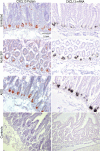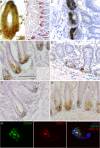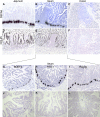Macaque paneth cells express lymphoid chemokine CXCL13 and other antimicrobial peptides not previously described as expressed in intestinal crypts
- PMID: 23803902
- PMCID: PMC3754526
- DOI: 10.1128/CVI.00651-12
Macaque paneth cells express lymphoid chemokine CXCL13 and other antimicrobial peptides not previously described as expressed in intestinal crypts
Abstract
CXCL13 is a constitutively expressed chemokine that controls migration of immune cells to lymphoid follicles. Previously, we found CXCL13 mRNA levels increased in rhesus macaque spleen tissues during AIDS. This led us to examine the levels and locations of CXCL13 by detailed in situ methods in cynomolgus macaque lymphoid and intestinal tissues. Our results revealed that there were distinct localization patterns of CXCL13 mRNA compared to protein in germinal centers. These patterns shifted during the course of simian immunodeficiency virus (SIV) infection, with increased mRNA expression within and around follicles during AIDS compared to uninfected or acutely infected animals. Unexpectedly, CXCL13 expression was also found in abundance in Paneth cells in crypts throughout the small intestine. Therefore, we expanded our analyses to include chemokines and antimicrobial peptides (AMPs) not previously demonstrated to be expressed by Paneth cells in intestinal tissues. We examined the expression patterns of multiple chemokines, including CCL25, as well as α-defensin 6 (DEFA6), β-defensin 2 (BDEF2), rhesus θ-defensin 1 (RTD-1), and Reg3γ in situ in intestinal tissues. Of the 10 chemokines examined, CXCL13 was unique in its expression by Paneth cells. BDEF2, RTD-1, and Reg3γ were also expressed by Paneth cells. BDEF2 and RTD-1 previously have not been shown to be expressed by Paneth cells. These findings expand our understanding of mucosal immunology, innate antimicrobial defenses, homeostatic chemokine function, and host protective mechanisms against microbial translocation.
Figures





Similar articles
-
Persistence of gut mucosal innate immune defenses by enteric α-defensin expression in the simian immunodeficiency virus model of AIDS.J Immunol. 2011 Feb 1;186(3):1589-97. doi: 10.4049/jimmunol.1002021. Epub 2010 Dec 22. J Immunol. 2011. PMID: 21178012 Free PMC article.
-
Defensin-mediated innate immunity in the small intestine.Best Pract Res Clin Gastroenterol. 2004 Apr;18(2):405-19. doi: 10.1016/j.bpg.2003.10.010. Best Pract Res Clin Gastroenterol. 2004. PMID: 15123078 Review.
-
Paneth cells, defensins, and the commensal microbiota: a hypothesis on intimate interplay at the intestinal mucosa.Semin Immunol. 2007 Apr;19(2):70-83. doi: 10.1016/j.smim.2007.04.002. Epub 2007 May 7. Semin Immunol. 2007. PMID: 17485224 Review.
-
Paneth cell alpha-defensins from rhesus macaque small intestine.Infect Immun. 2004 Mar;72(3):1470-8. doi: 10.1128/IAI.72.3.1470-1478.2004. Infect Immun. 2004. PMID: 14977952 Free PMC article.
-
Paneth cell alpha-defensins: peptide mediators of innate immunity in the small intestine.Springer Semin Immunopathol. 2005 Sep;27(2):133-46. doi: 10.1007/s00281-005-0202-x. Epub 2005 Jun 2. Springer Semin Immunopathol. 2005. PMID: 15931529 Review.
Cited by
-
The Role of Defensins in HIV Pathogenesis.Mediators Inflamm. 2017;2017:5186904. doi: 10.1155/2017/5186904. Epub 2017 Aug 3. Mediators Inflamm. 2017. PMID: 28839349 Free PMC article. Review.
-
The Role of Microbial Translocation and Immune Activation in AIDS-Associated Non-Hodgkin Lymphoma Pathogenesis: What Have We Learned?Crit Rev Immunol. 2020;40(1):41-51. doi: 10.1615/CritRevImmunol.2020033319. Crit Rev Immunol. 2020. PMID: 32421978 Free PMC article. Review.
-
The chemistry and biology of theta defensins.Angew Chem Int Ed Engl. 2014 Sep 26;53(40):10612-23. doi: 10.1002/anie.201402167. Epub 2014 Jul 30. Angew Chem Int Ed Engl. 2014. PMID: 25079086 Free PMC article. Review.
-
Micafungin Elicits an Immunomodulatory Effect in Galleria mellonella and Mice.Mycopathologia. 2016 Feb;181(1-2):17-25. doi: 10.1007/s11046-015-9940-z. Epub 2015 Sep 18. Mycopathologia. 2016. PMID: 26384671 Free PMC article.
-
On the Utility of Chemical Strategies to Improve Peptide Gut Stability.J Med Chem. 2022 Apr 28;65(8):6191-6206. doi: 10.1021/acs.jmedchem.2c00094. Epub 2022 Apr 14. J Med Chem. 2022. PMID: 35420805 Free PMC article.
References
-
- Gunn MD, Ngo VN, Ansel KM, Ekland EH, Cyster JG, Williams LT. 1998. A B-cell-homing chemokine made in lymphoid follicles activates Burkitt's lymphoma receptor-1. Nature 391: 799– 803 - PubMed
-
- Ebisuno Y, Tanaka T, Kanemitsu N, Kanda H, Yamaguchi K, Kaisho T, Akira S, Miyasaka M. 2003. Cutting edge: the B cell chemokine CXC chemokine ligand 13/B lymphocyte chemoattractant is expressed in the high endothelial venules of lymph nodes and Peyer's patches and affects B cell trafficking across high endothelial venules. J. Immunol. 171: 1642– 1646 - PubMed
-
- Yang D, Chen Q, Hoover DM, Staley P, Tucker KD, Lubkowski J, Oppenheim JJ. 2003. Many chemokines including CCL20/MIP-3α display antimicrobial activity. J. Leukoc. Biol. 74: 448– 455 - PubMed
Publication types
MeSH terms
Substances
Grants and funding
LinkOut - more resources
Full Text Sources
Other Literature Sources

